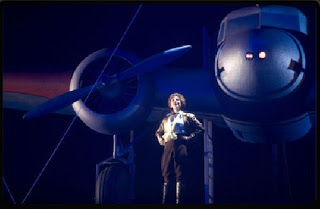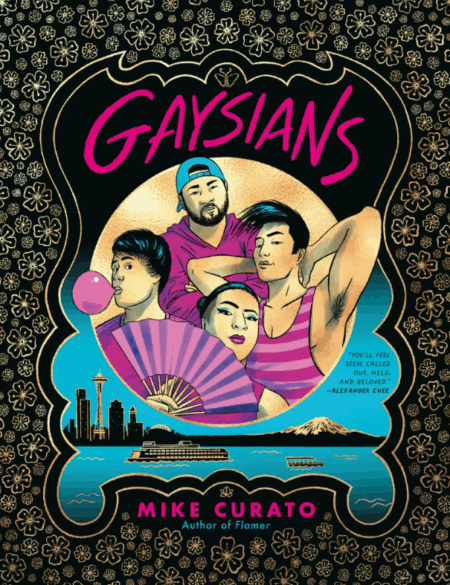Review: Amelia at Seattle Opera. Music by Daron Aric Hagen. Libretto by Gardner McFall. Story and Stage Direction by Stephen Wadsworth. Conducted by Gerard Schwartz. With Kate Lindsey, Nathan Gunn, Jennifer Zetlan, William Burden and Jane Eaglen.
Off the bat, let me make one thing clear: I am not an Opera buff or any sort of expert on Opera history, music or technique. (To be honest, I probably know more about Oprah than Opera.) I’m familiar with the plots of several classic operas, and recognize and admire many of the classic “songs” (see, I don’t even know the correct jargon on how to write about opera) but I can write about the drama and theatricality of a stage performance and Seattle Opera’s newly commissioned work Amelia, is a dramatically interesting, vibrant, layered piece of theater resonant with topicality, classical allusions and beautifully realized stagecraft and design with strong acting performances from the cast, lovingly composed and thoughtful stage direction and a musical score that is classical in nature but not afraid to reference cinematic music themes and structures and be very relatable for contemporary audiences raised on the film scores of Bernard Herrman, Jerry Goldsmith and John Williams. I wouldn’t call it a perfect production, but an interesting new piece that is not afraid to tackle contemporary subject matter and styles of acting, performance and design while still being respectful of operatic traditions and thematic elements. It was a moving piece of theater and one that made me anxious to sample other operatic works, particularly more recent works of the 20th and 21st century.
As for the plot of Amelia, it’s a tough show to describe. It follows the life of a woman, born circa 1960 and the effect the disappearance of her airman father during the Vietnam War has on her life and emotional well-being. Amelia is a young girl when her father vanishes in the skies over North Vietnam and the uncertainty of his fate and the subsequent revelation of what did happen to him, haunts not only her life and her relationship with her husband but any future relationships she might have with the child she is carrying. The opera opens on a typical suburban tract house as Dodge, her father says goodbye and goodnight to his daughter as he prepares to leave on his latest tour of duty. Seemingly disconnected from this tender father-daughter moment is the Mother, distracted and busy in another part of the house, who is soon alarmed to see a very large and very official looking hearse-like car pull in front of her house and a contingent of grim military personnel, including a chaplain, come up to her front door with some disturbing news. This dramatic device, the simultaneous portraying of different characters, both real and fantastical, in different time frames and levels of alternate reality or fantasy, is used throughout the show in all six scenes of the opera. In Scene 1 we juxtapose between the night that Dodge left on his tour of duty and the day a few weeks later when his disappearance is revealed to his wife. A third plane of existence is revealed when the cockpit of an airplane emerges in the skies over the suburban home and a woman, only identified as “The Flier” but undoubtedly the aviatrix Amelia Earhart is facing the last moments of her life on her final flight in 1937. In Scene Two, we now meet the adult Amelia, married and in the last month of her pregnancy, as she wakes up and sends her husband, (an engineer for an aircraft company) off to work but simultaneously in the room the mythic Daedalus instructs his son Icarus, busy building the wings that will hopefully fly him to freedom, to not get to close to the sun when he takes flight. The interplay between the real and the mythic and the allusions to classical characters both real and imaginary and their fascinations with flight and the rewards and risks of taking chances is key to the themes of the opera and the integrity of the dramatic plot. It also makes for both a thought-provoking and dense drama as well as an opportunity for imaginative and exciting visual elements in both the staging and the design of the production.
And key to the success of the show is the work by the design team. Tony nominated set designer Thomas Lynch beautifully and eloquently creates a world that not only encompasses a suburban 1960’s tract house and a simple 1990’s apartment but a rural Vietnamese village, a streamlined office in a Boeing type aircraft facility, a hospital room and maternity ward and still manages to find room on the stage for a Lockheed Model 10 Electra airplane and a vintage mid 60’s four door sedan. His creative use of scrims to separate rooms and realities on stage is only enhanced by the artistry of Duane Schuler’s subtle but eloquent lighting design. The work of the two men is fully realized in what could have been the most banal of sets, a waiting room and corridor outside of a maternity room in a utilitarian hospital, but the lovely Bauhausian lines of the design and the amber textural warmth of the lights turn potential banality into a work comparable to the work of the finest Old Master painter. It’s a heartbreakingly and beautifully composed piece of art.
And, lastly, a word on the performances. Opera has changed a lot in the last 20 years with a greater emphasis on dramatic performance and characterization. The modern opera singer is required not only to be a perfect technical singer but an actor as well, and the cast of Amelia contains performances that would be just as perfectly at home on the stages of the Intiman or Seattle Rep as on the stage at McCaw Hall. William Burden’s father, Dodge, is a perfect example of a leading man who is just as comfortable playing tender love scenes with his daughter as he is hitting a high note, and does an excellent job playing both the tender moments with his daughter and the action movie moments in the scenes detailing his last moments in Vietnam. Nathan Gunn as Amelia’s husband Paul doesn’t really have much to do other than be a patient, loving husband to his anguished and pregnant wife but he’s got the looks, the bearing and the voice to make his underwritten role memorable enough to warrant checking out his bio in the program. Jennifer Zeitan’s “Aviator” doesn’t really physically resemble the boyish looking Earhart but her soaring voice and cool demeanor project both the fiery passion and gentle determination of the woman and her contentment that she got to live her brief but eventful life the way she wanted, with courage and conviction and love for new challenges.
As for the two “divas” of Amelia, they both shine. Jane Eaglen is a beloved figure, not only at the Seattle Opera where she has won acclaim for her signature roles as Bellini’s Norma, Wagner’s Isolde and most notably, as Wagner’s Brunnhilde in productions of the Ring Cycle not only in Seattle but at The Met, La Scala, Vienna, San Francisco and many other great opera houses in the world. Ms Eaglen IS a treasure and the audience greeted both her and her huge voice with warm welcoming arms when she made her entrance in the second scene of the second act. Her role as Amelia’s aunt Helen, the sister of her father Dodge, is small but her voice and the persona she brings to the stage are not. It’s not a star-making role, but a star MAKING the role and fitting it like a glove to her talent. I’m very happy I had the chance to see Jane Eaglen in performance.
As for Amelia herself, I’m happy to report that the beautiful and talented Kate Lindsay was very good in a very difficult role. Amelia is not always an easy character to love, or, to even like. We see her at three different stages of her life: a girl of 10 or so who loves her father and loves the idea of being able to fly; a young woman in her 20’s visiting Vietnam and shocked to discover the fate of her father and finally, in the majority of the opera, as a woman in her 30’s, married and pregnant and still very traumatized about what happened to her father and sabotaging the relationships around her. Amelia, as an adult, has almost Oedipal feelings toward her father and her obsessive angry behaviour is both off-putting and a bit creepy. She is bent on pushing her husband away and demands he give up his job working on a top-secret aviation plan which might be a design for a new bomber. Her anger and rage lead her to irrational behaviour and possible harm to her unborn child. All these unsympathetic qualities are difficult for any actress to portray and even more so when required to play them while singing very technically demanding music, but Kate Lindsay is up to the task and she manages to make a rather unpleasant character sympathetic enough to want to listen to her story for two hours. Ms Lindsay has the chops to play all the different layers of a very complicated character and make that character viable and worth knowing.
The end of this opera is not particularly original or clever, but it is beautifully staged. We see Amelia and Paul in the maternity room holding their new child and Aunt Helen is hovering nearby. Doctors and nurses leave the room and some walk down the corridor and others collapse in chairs in the waiting area where a grieving father also sits, the personal effects of his dead son in his hands. The music is triumphant and soaring as death gives way to life and they all sing, “The Risk is Worth the Love” but an even more telling line is sung by The Aviator/Amelia Earhart who has been observing and commenting on all the action in the hospital. Her final solo line is the simple, heartfelt declaration, “I was never, never bored!” and I have to admit that I have to agree with her.
Amelia continues at Seattle Opera this Wednesday, May 19; Friday, May 21 and Saturday, May 22 at 7:30pm. The Friday performance is a designated LGBT Night at the Opera with a special reception starting at 6pm.
All photos: Rozarii Lynch/Seattle Opera
-Michael Strangeways











